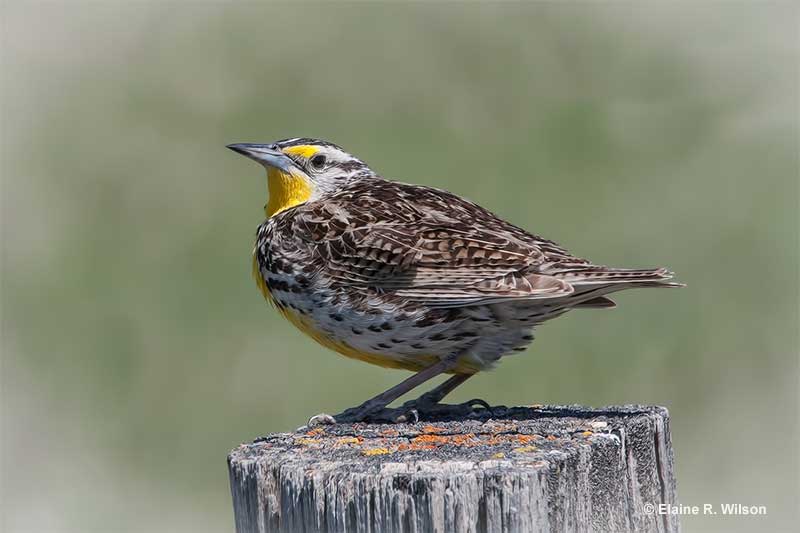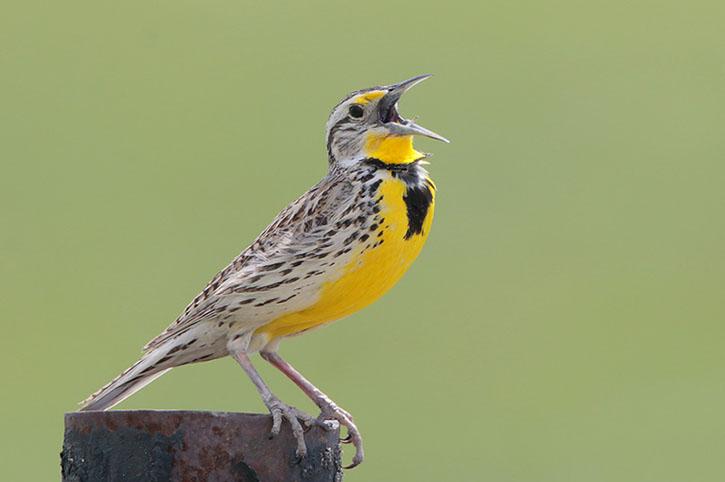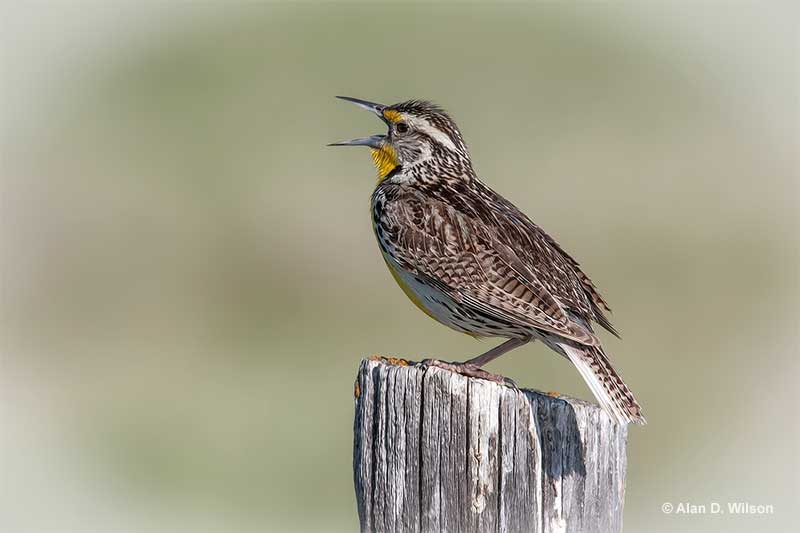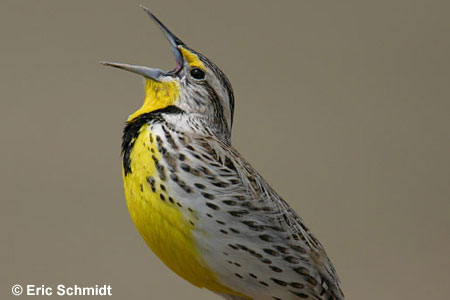
Nebraska is a midwestern U.S. state whose terrain consists of plains, sandhills, salt marshes, and rock formations. It’s a larger state with a population of 1.9 million and a 77,348 sq mile size.
Nebraska state bird is the Western Meadowlark. These birds can be found throughout the midwestern and western portions of the United States.
Western Meadowlarks are medium-sized birds and are known for their bright plumage.
On this page
Nebraska State Bird
The Western Meadowlark officially became the state bird of Nebraska in March 1929.
The NFWC, Nebraska Federation of Women’s Clubs, came to a vote and decided on the Western Meadowlark as the Nebraska state bird.

They approached the Hamilton County representative Rundle to introduce a concurrent and joint resolution that proclaimed the Western Meadowlark as the state bird. It passed, and the then-governor Adam McMullen signed the bill into law.
Nebraska isn’t the only state that has the Western Meadowlark as the state bird – Wyoming, Kansas, North Dakota, Oregon, and Montana chose this Meadowlark as their state bird as well.
This bird primarily inhabits the prairies, buttes, and bluffs of the state but can also be seen flitting among its mountains and wilderness. The bird was believed to be chosen for this role because of its abundance in the state and it being discernable with their bright yellow stomachs and chests.
Fun Facts about Western Meadowlarks
- These birds are primarily active during the day. This is when they spend most of their time singing beautiful songs and foraging for food. They’re birds that feed on the ground and eat foods like seeds, berries, and insects.
- The scientific name for the Western Meadowlark is Sturnella neglecta.
- Western Meadowlarks are not commonly seen in backyards. However, they will visit yards in rural agricultural areas. You can try attracting these birds to your yard by providing enough perching areas, grass seeds, and open areas. Additionally, you can add a ground bird bath to your yard.
- The Western Meadowlark is known to be relatively territorial. They nest on the ground during the breeding season and often chase off other males. Additionally, they’ll defend their territory from predators like foxes and coyotes.
- The Western Meadowlark is an amazing-looking bird that can be easily identified by its unique plumage. They have a buff and black pattern on their upper bodies and a large black “V” on their chests.
- Western Meadowlarks are migratory. They spend their winters in Mexico and the southern portions of the United States, and they migrate back to Canada in late April/early May.
- While the Western Meadowlark is not endangered and has a status of least concern, they’re often targeted by predators such as weasels, owls, coyotes, cats, raccoons, snakes, and eagles.
- In the wild, these birds typically live for 2 to 4 years, but they can live up to 10 years in captivity.
- The Western Meadowlark is known to use cow dung as a perch to sing from. It’s theorized that this helps them attract mates and defend their territory.
- Western Meadowlarks have been observed using tools like sticks to remove insects from cracks.
Identification
The Western Meadowlark is a boldly marked and colorful bird; their plumage is crucial to their identification. Female and male birds look similar, with a heavily spotted beige body, a solid black V-shape on the chest, thin black stripes on the wings, and black stripes or spots on the flanks.

The abdomen, chest, and throat are yellow, and they have a slight yellow patch over the eye. They also have a white eyebrow that contrasts with the black lines on the head. Additionally, the grayish bill tapers sharply and is somewhat long. The legs and feet are pale, and theirs some white on the outer tail feathers.
Young Western Meadowlarks look like adults, but their markings may not be as bold, and their color is usually duller overall.
Western Meadowlarks look extremely similar to Eastern Meadowlarks, so your best bet is to identify by voice. For birds that aren’t singing, look for a primarily white mustache stripe and darker head stripes on Eastern birds. They also have a little bit more white in their tail than Western Meadowlarks.
If you’re looking for this bird, you’ll probably hear them before you see them. They like to perch in the open and sing loudly, making them fairly easy to find within their range.
Western Meadowlarks start singing earlier in the day, and their bold markings make them easy to see from a distance. We recommend looking for these birds along rural roadsides or perched on top of rocks in brushy fields, solitary trees, and even bushes.
What do Western Meadowlarks eat?
Western Meadowlarks are ground-feeding birds and rely on a varied diet to maintain their energy levels and health.
They mostly consume insects like ants, mosquitoes, grasshoppers, cockroaches, crickets, flies, and carpenter ants. However, they will consume other insects as well.
Western Meadowlarks will supplement their diet with plant-based foods such as seeds, berries, acorns, and pine cones. These adaptable birds have even been observed scavenging in harvested cornfields and eating seed pods from dead plants.
Call
The Western Meadowlark has a distinctive song; it’s arguably the most identifiable characteristic of these birds. Short pitched notes that vary but are repeated with pauses between them. You can use their distinct call to locate them.
They are often seen singing from perches such as fences, wires, plant stalks, and posts, which makes them easy to find for a visual. The song can sound deep and throaty, though these birds will also use “chirp” and “chip” calls. These birds are loud and can be heard from a pretty good distance.

Behavior
Western Meadowlarks are birds that usually keep to themselves but can be found in pairs during the breeding season. However, they occasionally form small flocks during other times of the year, especially in the colder months.
These birds usually fly low to the ground, above the grass, with quick wing beats. You’ll almost never see them flying at larger heights.
Other Common Birds In Nebraska
Nebraska has over 400 bird species – there’s no point in naming them all, but here are some of the most common ones:
- American Robin
- Blue Jay
- Northern Cardinal
- Mourning Dove
- House Sparrow
- Canada Goose
- European Starling
See more – most common birds of Nebraska
Frequently Asked Questions
How many bird species are in Nebraska?
There are 467 bird species in Nebraska.
What is the rarest bird in Nebraska?
The rarest bird in Nebraska is the Whooping Crane.
What birds is Nebraska known for?
The birds Nebraska is known for are the Western Meadowlark, the Northern Cardinal, the Mourning Dove, and the American Goldfinch.

